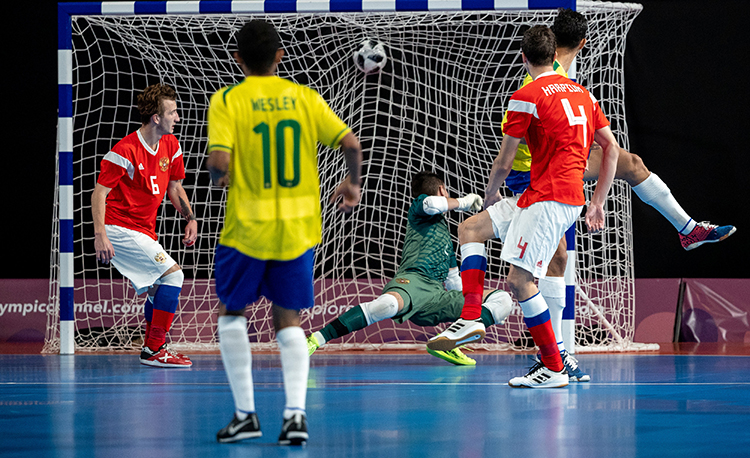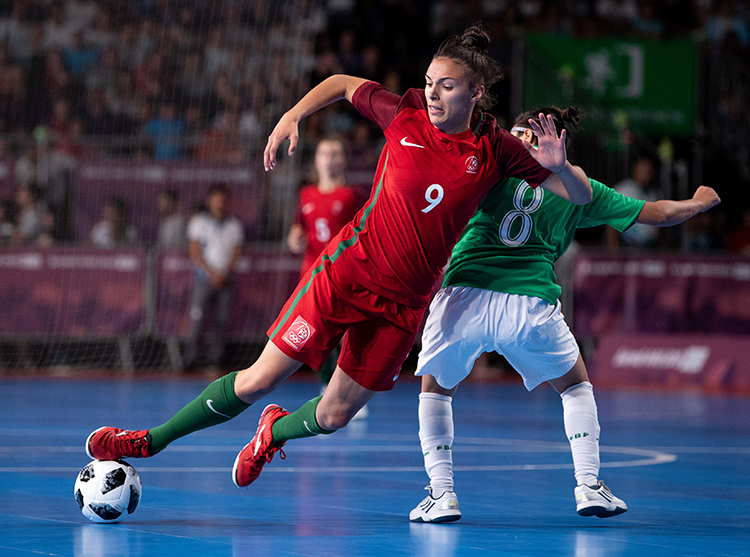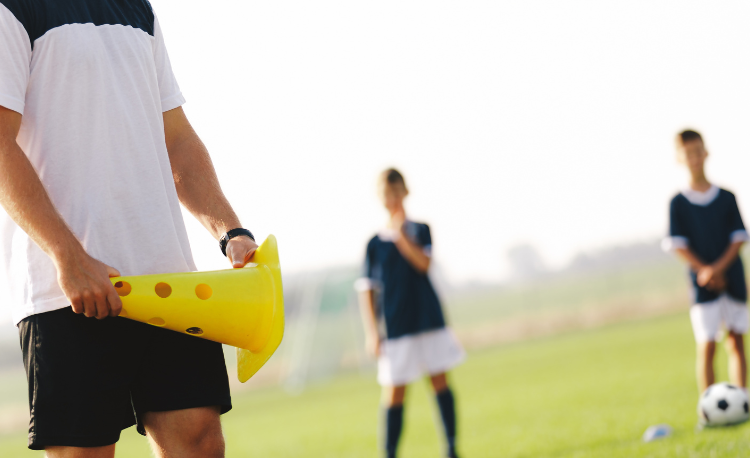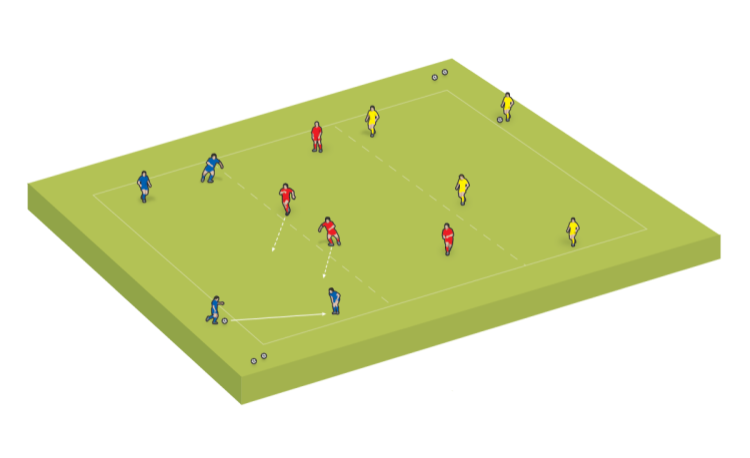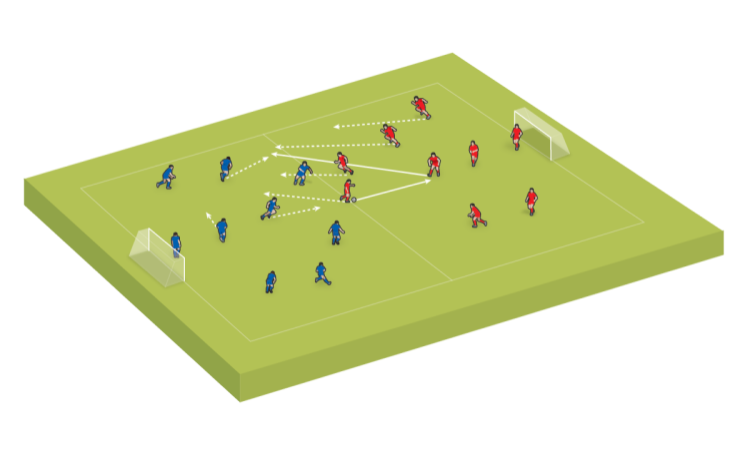Tactical benefits of incorporating futsal
Russell Fryer discusses movement and creating overloads in futsal
In this article, we will look at the tactical side of futsal and how it can also be transferred over into soccer.
Let’s begin with rotations and their relation the ‘pass and move’ you hear mentioned so often in the soccer world. The main difference in futsal is that when you pass you are encouraged to move forward.
Futsal is a riskier game than soccer and players are not usually fixed to their positions. They are encouraged to move forward quickly and look to receive the ball in pockets of space between the lines.
Once a player moves into space, they will consider if they can receive and play forward again. This determines whether they rotate back to the original formation or if their teammates rotate to cover a forward run.
In futsal, this is done all over the court. In soccer, we tend to only see these kinds of movements in the final two thirds of the pitch, between the midfielders and forwards.
For example, the Liverpool team from 2017 to 2022, which had a front three of Sadio Mane, Mohamed Salah and Roberto Firmino, was often said to have no formation, such was the fluidity of the players’ positioning and the rotation between them.
Another perfect example was Pep Guardiola’s Barcelona team of 2008-2012, where the likes of Lionel Messi (in his ’false nine’ role), Xavi, Andres Iniesta and Sergio Busquets would form a diamond that would rotate constantly, mesmerising opposition players with their passing and movement.
"Futsal is a riskier game than soccer - players are not usually fixed to positions..."
None of them appeared fixed to a specific position and they all exchanged places fluidly as they transferred the ball forward.
The interesting thing here is that none of those Barca players mentioned were blessed with pure speed, but all were a step ahead in terms of spatial awareness, allowing them to ghost into areas in between their opponents.
Is it a coincidence these players all played futsal? In fact, they often cite futsal as one of the main reasons for their style of play.
Overloads (2v1 and 3v2)
In futsal, one of the areas coaches look to work on a lot is developing overloads.
This is a crucial aspect of the game, given there are only four outfield players and less opportunity for players to find space.
Creating overloads in futsal requires a lot of effort in terms of rotation and fake movements (’show and go’/’go and show’).
Lots of two-player moves - such as wall passes, diagonal passes and straight runs (and vice versa), overlaps, pass and follow and lending passes - take place in futsal, to create 2v1 or 3v2 situations.
Quite often, if executed correctly, these can result in a finish at the far post, especially as there is no offside in futsal.
In modern-day soccer, more coaches are looking to create overloads in certain areas of the pitch, particularly in wider areas in order to isolate the full-back and create crossing opportunities.
Many in-possession exercises incorporate the creation of overload opportunities on the opposite side of the pitch from the larger concentration of players.
Teams like Manchester City, Paris Saint-Germain and Bayern Munich are very good at drawing their opponents over to one side of the pitch, in order to switch play quickly and expose players in 2v1 or 3v2 situations.
This requires a great deal of focus and the ability to control possession in the smaller, more condensed area of the pitch - often putting together dozens of passes on one side before the transition can take place into the open area on the opposite side.
By switching the ball at this particular moment, there is usually an opportunity to isolate the full-back and create a 2v1 situation. Then, if the player on the ball can play at speed and be decisive, and the supporting player can make creative and well-timed movements, it puts the defender in a very difficult position.
Could it be that a coach like Pep Guardiola is learning from his futsal days and blending this into his soccer tactics and philosophy?
Those who have played futsal will develop an ability to create overload scenarios more effectively, as they are performing the associated actions a lot more often and more quickly on a futsal court, where space is limited and reaction times are enhanced.
Many of a player’s movements in futsal are made for their team-mates and not for themselves. By making the right type of run, it can create space for another player to move into and exploit.
"More coaches are looking to create overloads in certain areas of the pitch..."
Also, by applying this constant rotation it can disorientate the opposition and force them into making an error, leaving space where an overload can be executed.
With some of the largest soccer teams around the world having affiliated futsal teams - Barcelona, Benfica, Boca Juniors, Sporting and Sampdoria, to name just a few - and the countless players that have come through futsal and into top-flight soccer, it seems inevitable more will follow suit.
I coach hundreds of grassroots soccer players in futsal sessions every week and see the progress they make, compared to their peers who only play soccer - and there are many other coaches who do the same.
If we can help to open the eyes of other soccer coaches - and young players’ parents - to the wonders of futsal and its benefits in relation to player development, then soccer will be the real winner.
Related Files
Newsletter Sign Up
Coaches Testimonials

Gerald Kearney, Downtown Las Vegas Soccer Club

Paul Butler, Florida, USA

Rick Shields, Springboro, USA

Tony Green, Pierrefonds Titans, Quebec, Canada
Subscribe Today
Discover the simple way to become a more effective, more successful soccer coach
In a recent survey 89% of subscribers said Soccer Coach Weekly makes them more confident, 91% said Soccer Coach Weekly makes them a more effective coach and 93% said Soccer Coach Weekly makes them more inspired.
*includes 3 coaching manuals
Get Weekly Inspiration
All the latest techniques and approaches
Soccer Coach Weekly offers proven and easy to use soccer drills, coaching sessions, practice plans, small-sided games, warm-ups, training tips and advice.
We've been at the cutting edge of soccer coaching since we launched in 2007, creating resources for the grassroots youth coach, following best practice from around the world and insights from the professional game.

